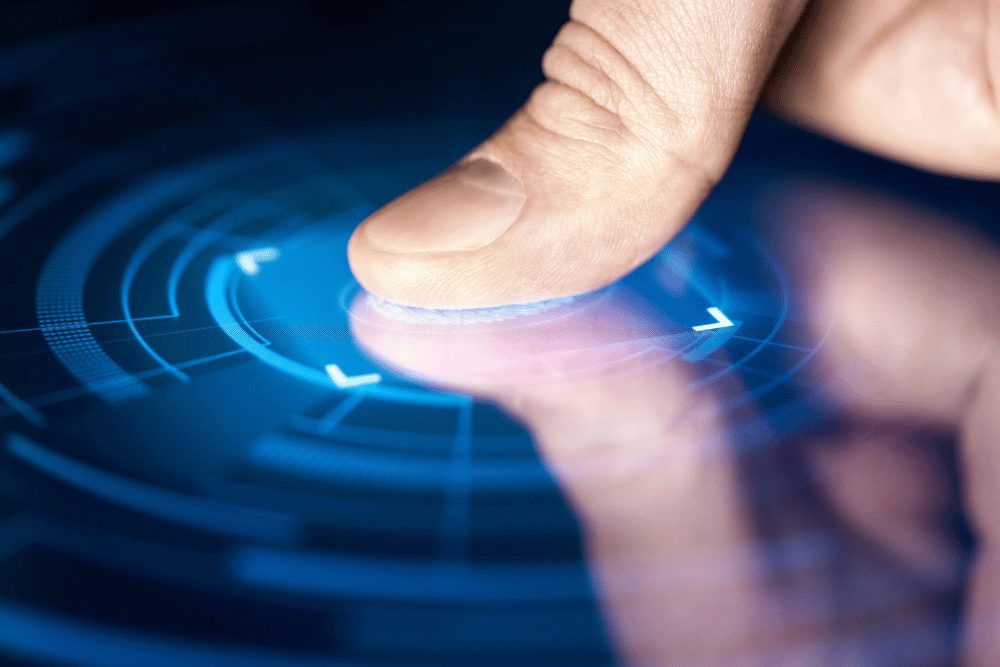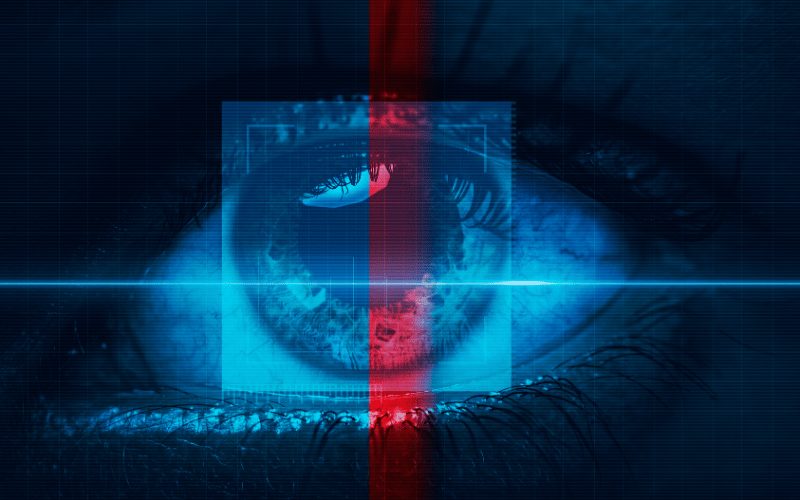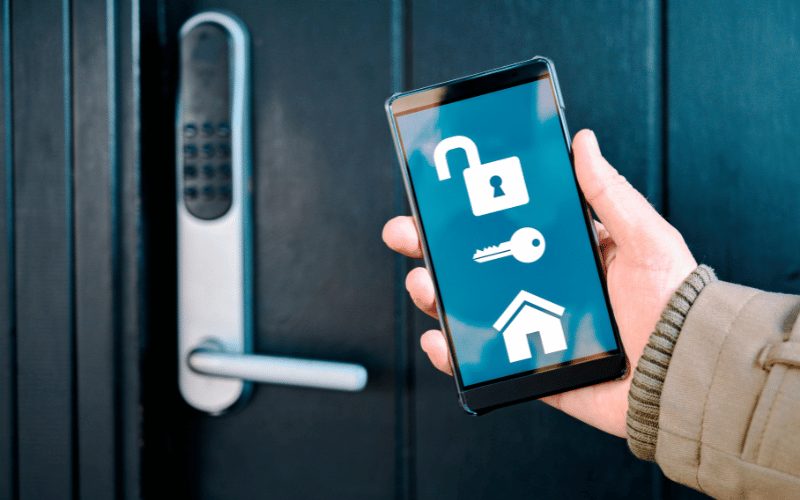How Do Biometric Locks Work?

It’s undeniable how quickly technology is improving our everyday lives. Things are changing so rapidly that innovative solutions to old problems arise almost daily. Among these new solutions are biometric locks. This new generation of security technology offers an additional layer of protection that combines effectiveness with convenience.
Admittedly, biometric technology can be confusing. But once you understand how these tools use unique identifiers to control user access, it’s easy to see the endless applications in security.
Below, we’ll explore how biometric locks work, their significance in a multi-layered security system, various types, and how you can integrate them into your home for increased security.
Understanding Biometric Technology
First: How do biometric locks work?
Biometrics are unique physical or behavioral characteristics. Fingerprints are the most obvious example, but there are lots of other identifiers that are specific to each person. Think of retinas, facial features, voice patterns, and hand shape, for example.
Biometric security uses these identifiers to verify an individual’s identity before giving access to a location or device. When you install a biometric lock, it compares the presented biometric input to pre-stored information. If there’s a match, you’re in!
You probably already use biometric security on some personal devices. If you’ve scanned your thumb to unlock your phone or trained your smart hub to listen for your voice, you’re employing biometric technology.
Types of Biometric Locks
Have a specific need or preference? There are plenty of biometric locks to choose from.
- Fingerprint Locks: Fingerprint recognition is one of the most widely adopted biometric security methods. These locks scan and analyze the unique patterns and ridges on your fingertip to grant access.
- Retina and Iris Scanners: Retina and iris scanners evaluate intricate patterns within the eye to identify individuals. While highly accurate, they can be pricier and more invasive than other biometric methods.
- Facial Recognition: Facial recognition technology scans your face and identifies key facial features to authenticate users. This method is convenient, contact-free, and non-invasive, making it a popular choice for various applications. That said, a person’s appearance isn’t necessarily predictable or even unique. (Identical twins, we’re looking at you!)
- Voice Recognition: Voice recognition biometric locks analyze vocal patterns to verify an individual’s identity. These systems are less common but offer another option to add a layer of security.
- Palm and Hand Geometry: Hand geometry biometric locks examine the size and shape of your hand, making them a practical choice for physical access control.
And that’s just the beginning. There’s even a type of biometric lock that analyzes the unique heart rhythm of the user, making it virtually impossible to fool.
Some of these options may seem over the top. However, depending on your specific needs, the variety of options can be beneficial.

Installing Biometric Locks in Your Home
One compelling aspect of biometric locks, particularly for homeowners, is how easy they are to install. Many are perfect for DIY installation. They typically come with straightforward instructions and require only basic tools. Biometric locks can replace existing locks or even integrate with them.
However, before choosing a biometric lock, it’s important to consider a few key factors. These include:
- Power Source: Ensure that you have access to a power source for the lock, whether it’s battery-operated or requires an electrical connection.
- Compatibility: Confirm that the chosen biometric lock is compatible with your door type, whether it’s a standard door, a smart door, or an access control system.
- Positioning: Properly align and install the lock for optimal performance, following the manufacturer’s guidelines.
- Security Settings: Customize the lock’s security settings to your specific needs, such as adjusting sensitivity or setting up user profiles.
Fingerprint locks are by far the most common biometric security option for residential properties. You can expect to pay anywhere from $50 to $200 for the hardware, depending on the brand and features. Installation could take as little as 15 minutes.
Seamless Smartphone Integration
One feature of many biometric locks that stands out is the ability to integrate with almost any smartphone, typically through a dedicated mobile app. With this integration, you can remotely control your lock and grant or revoke access to individuals. This is especially handy for allowing trusted parties like house sitters or nannies to enter your home while you’re away. The owner can also receive real-time notifications about any activity, including attempted entries or successful access.
Many biometric lock manufacturers prioritize data security, ensuring that your biometric information is stored and transmitted securely through encrypted channels. That eases the minds of many users who fear data breaches or are apprehensive about giving up control of their personal information.
In many cases, biometric locks can also be integrated with other smart home devices like smart hubs. For homeowners looking to achieve the ultimate smart home, it’s something to consider.
However, always remember that interconnected systems are more susceptible to hacking and breaches. If a malicious party were to gain access to your home system through an insecure device, they might also have control over your locks. The last thing you need is someone breaking into your house because you integrated your security devices with a cheap smart outlet, for example.

Advantages of Biometric Locks Over Traditional Methods
The most notable benefit of biometric security technology is how difficult it is to dupe. Biometric data is highly individual, making it incredibly challenging for unauthorized users to replicate or mimic. By comparison, traditional methods like PIN codes or keys can be lost, stolen, or guessed.
Unlike physical keys or access cards, biometric data cannot be easily shared or transferred between individuals. In other words, you don’t have to worry about your kids making copies or the former owners returning without permission.
Biometric locks also eliminate the need to carry keys or remember passwords. This is doubly beneficial. It makes access convenient, even for those with limited motor skills or full hands of groceries. At the same time, it eliminates problems with lost or stolen credentials.
Possible Downsides to Biometric Locks
Biometric locks are a modern and handy security choice. However, they come with their own set of challenges.
This technology uses your personal features for access. If this data is not properly secured, bad actors can misuse it. That’s more than enough reason to buy a lock from a reputable company.
Not all biometric locks fit all door types or security systems. So, be extra safe and make sure you review the technical details and measurements before you purchase.
As with most technology, technical errors and glitches are possible. The system might deny access to authorized users or approve access for unauthorized ones. Although these instances are rare, they happen. If you purchase a biometric lock system, have a backup plan, such as a side entrance or a secondary access control mechanism. To prevent common errors, keep the sensor clean and (for fingerprint readers) sync multiple fingers in case of injury.
Biometric locks also present a minor hacking risk. If you use a smartphone to control your lock, make sure you can trust your phone’s reliability and security. Typical security hygiene practices apply: make regular system updates, minimize how many devices you have on the same network, and use layered or redundant security measures. The good news is that it’s much harder to hack a biometric lock than it is to pick a standard keyed lock.
The Importance of Biometrics for Layered Security
Biometric technology can play a pivotal role in a multi-layered security plan. Overall, biometric locks increase your home’s security through deterrence. It’s undoubtedly a passive type of deterrence, similar to a fence or signage. But every element that makes a home an unattractive or difficult target is a boon.
As a homeowner, it’s critical to take an active role in selecting the best security for your home. Research your options, seek advice from security professionals, and layer powerful security measures for comprehensive coverage.
A great pairing for your biometric lock is a video surveillance system backed by live security guards. Deep Sentinel’s smart security cameras detect intruders on your property before they can reach your front door. With AI-powered live surveillance providing a first line of defense and biometric locks serving as backup, your home is one step closer to being an impenetrable fortress.
Need a Solution that Prevents Crime?
Deep Sentinel is the only security technology that delivers the experience of a personal guard on every customer’s home and business. Visit deepsentinel.com or call 833.983.6006.

